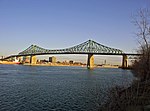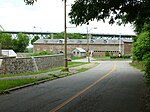La Ronde (amusement park)
La Ronde (lit. 'The Round') is an amusement park located in Montreal, Quebec, Canada. It was originally built as the entertainment complex for Expo 67, the 1967 World Fair. Today, it is operated by Six Flags, under an emphyteutic lease with the City of Montreal until 2065. In-addition to being the Six Flags chain's northernmost location, La Ronde is the largest amusement park in Quebec and the second-largest in Canada (behind Canada's Wonderland, operated by Cedar Fair).La Ronde occupies 59 hectares (146 acres) of the northern tip of Saint Helen's Island, situated on a man-made extension to the landmass; the park is in the vicinity of where the smaller, adjacent Ronde Island had once been (the origin of the park's name). The park hosts the annual Montreal Fireworks Festival, an international fireworks competition. La Ronde and Frontier City in Oklahoma City, Oklahoma are the only two Six Flags-operated parks not officially-branded as Six Flags parks.
Excerpt from the Wikipedia article La Ronde (amusement park) (License: CC BY-SA 3.0, Authors).La Ronde (amusement park)
Pont Jacques-Cartier, Montreal Ville-Marie
Geographical coordinates (GPS) Address Website External links Nearby Places Show on map
Geographical coordinates (GPS)
| Latitude | Longitude |
|---|---|
| N 45.5225 ° | E -73.535 ° |
Address
La Ronde
Pont Jacques-Cartier 22
H3C 6A3 Montreal, Ville-Marie
Quebec, Canada
Open on Google Maps










